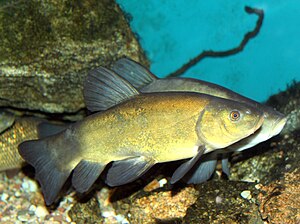Tench
The tench or doctor fish (Tinca tinca) is a freshwater and brackish water fish of the cyprinid (commonly called 'carp') family found throughout Eurasia from Western Europe including the British Isles east into Asia as far as the Ob and Yenisei Rivers. It is also found in Lake Baikal.[2] It normally inhabits slow-moving freshwater habitats, particularly lakes and lowland rivers.[3]
Ecology[edit]
The tench is most often found in still waters with a clay or muddy substrate and abundant vegetation.[4] This species is rare in clear waters across stony ground, and is absent altogether from fast-flowing streams. It tolerates water with a low oxygen concentration,[2] being found in waters where even the carp cannot survive.[4]
Tench feed mostly at night with a preference for animals, like chironomids on the bottom of eutrophic waters[5] and snails and pea clams in well vegetated waters[4][6]
Breeding takes place in shallow water usually among aquatic plants where the sticky green eggs can be deposited.[2] Spawning usually occurs in summer,[3] and as many as three hundred thousand eggs may be produced.[7] Growth is rapid, and fish may reach a weight of 0.11 kg (0.25 lb) within the first year.
Morphology[edit]
Tench have a stocky, carp-like shape, olive-green skin, darker above and almost golden below. The caudal fin is square in shape. The other fins are distinctly rounded in shape.[4] The mouth is rather narrow and provided at each corner with a very small barbel. Maximum size is 70 cm, though most specimens are very much smaller.[8] A record fish caught in 2001 in England had a weight of 15 lb 3 oz (6,89 kg). The eyes are small and red-orange in colour.[2] Sexual dimorphism is weak, limited to the adult females having a more convex ventral profile when compared with males.[8] Males may also possess a very thick and flattened outer ray to the ventral fins.[citation needed] Males are generally smaller than females but can be recognised by having more curved lower fins and noticeable muscles around the base of the fins generally absent in female.
The tench has very small scales, which are deeply imbedded in a thick skin, making it as slippery as an eel. Folklore has it that this slime cured any sick fish that rubbed against it, and from this belief arose the name doctor fish.[7]
Golden tench[edit]
An artificially-bred variety of tench called the golden tench or schlei is a popular ornamental fish for ponds. This form varies in colour from pale gold through to dark red, and some fish have black or red spots on the flanks and fins. Though somewhat similar to the goldfish, because these fish have such small scales, the golden quality is rather different.[7]
Economic significance[edit]
Tench are edible, working well in recipes that would otherwise call for carp.[4] They are an important target for coarse anglers and are also used as fodder for predatory species such as bass.[2] Tench, particularly golden tench, are also kept as ornamental fish in ponds and less frequently aquaria.[9]
Angling[edit]
Large tench may be found in gravel pits or deep, slow-moving waters with a clayey or silty bottom and lots of aquatic vegetation. The best methods and bait to catch tench are float fishing and legering with a swim feeder using maggots, sweetcorn, pellets, bread, and worms as hook bait and groundbait in the swimfeeder if you are not float fishing. Due to the tench being a bottom feeder, it is essential that your bait is resting on the bottom of the lake/pond/canal bed when float fishing—use a plummet to make sure your bait is resting on the bottom by an inch or two. Fish over 1 kg (2 lb) in weight are very strong fighters when caught on a rod.[7]
References[edit]
- ^ Freyhof, J. & Kottelat, M. (2008). Tinca tinca. In: IUCN 2008. IUCN Red List of Threatened Species. Retrieved January 25, 2010.
- ^ a b c d e Froese, Rainer and Pauly, Daniel, eds. (2007). "Tinca tinca" in FishBase. 5 2007 version.
- ^ a b B. Whitton (1982). Rivers, Lakes and Marshes p 163. Hodder & Staughton, London.
- ^ a b c d e A. F. Magri MacMahon (1946). Fishlore, pp 156-158. Pelican Books.
- ^ http://onlinelibrary.wiley.com/doi/10.1111/j.1095-8649.1996.tb01481.x/abstract
- ^ http://www.jstor.org/pss/1939640
- ^ a b c d A. Lawrence Wells (date unknown). Observer Book of Freshwater Fishes, pp 101-105. Frederick Warne & Co.
- ^ a b G. Sterba (1962). Freshwater Fishes of the World pp 249-250. Vista Books, London.
- ^ Dick Mills (2000). Understanding Coldwater Fish, p 106. Interpet Publishing. ISBN 1-903098-10-6
![]() Wikimedia Commons has media related to: Tinca tinca
Wikimedia Commons has media related to: Tinca tinca







